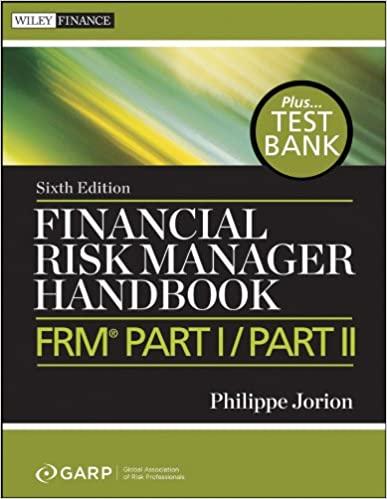Question
You are a financial advisor, providing advice to David. You are aware that there are a variety of ways in which David might make his
You are a financial advisor, providing advice to David. You are aware that there are a variety of ways in which David might make his capital allocation decision, and you aim to explore these with David. For the purposes of this question, we assume David can both borrow money and lend it in unlimited amounts at a rate of interest of 1%.
You have identified what you believe to be an optimal portfolio of risky assets A for David. It includes the following asset classes:
National stocks 60%
International stocks 20%
Non-equity investments 20%
Portfolio A has an expected return of 11% and a level of risk given by the standard deviation of its annual returns of 20%.
1. Explain what must be true for this portfolio to be the optimal risky portfolio for David. Illustrate your argument using a relevant diagram, and with reference to the reward to variability ratio.
2. Under what circumstances is portfolio A correctly defined as the optimal risky portfolio for all your clients (and not only David), regardless of their degrees of risk aversion?
3. David initially has the opinion that he should aim for an expected return on his combined portfolio of at least 13% pa (to secure the kind of retirement he is hoping for).Advise him on the minimum level of risk he will have to tolerate, and on the weightings of national stocks, international stocks and non-equity investments in his combined portfolio. Identify the implications for his lending/borrowing decision.
4. Following a further interview with you, David has a greater awareness of the potential risks of these investments to his future wealth, and changes his decision criterion for capital allocation to a maximum degree of risk on his combined portfolio of 15%. Advise him on his maximum expected return and on the weightings of national stocks, international stocks and non-equity investments in his combined portfolio. Identify the implications for his lending/borrowing decision.
5. You have recently read some research published by the CFA which has convinced you to attempt to optimise Davids capital allocation decision, using the diagram from investor utility (or certainty equivalence). Following a series of interviews, you estimate that David has a coefficient of risk aversion of approximately 2.0. Advise him on the lending/borrowing decision which will maximise his expected utility, and on the proportions of national stocks, international stocks and non-equity investments in his optimal combined portfolio. Assess his resulting estimated expected return and risk.
Step by Step Solution
There are 3 Steps involved in it
Step: 1

Get Instant Access to Expert-Tailored Solutions
See step-by-step solutions with expert insights and AI powered tools for academic success
Step: 2

Step: 3

Ace Your Homework with AI
Get the answers you need in no time with our AI-driven, step-by-step assistance
Get Started


